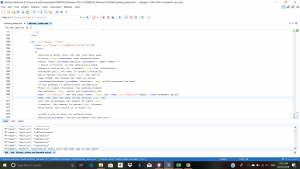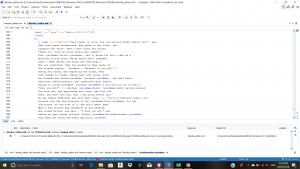Given the implications in the name of the course itself, “Humanities 100”, it was only inevitable that this class had a consistent theme of analyzing the effects of digital humanities on society. It does not take a rocket scientist to figure out how drastically technology has changed the very world we live in today. For example, imagine the typical tourist wandering around the Big Apple. After maneuvering through the hordes of people glued to their cellphones, this tourist looks up and see the endless flashing monitors of Times Square. Finally, after a full day of festivities, this tourist finds his/her way back to their grandparents’ apartment who then proceed to complain how none of these fancy gadgets or screens even existed back in their generation. Needless to say, the world has experienced a technological explosion. The question is where did this sudden incorporation of technology derive from, and what are the consequences? A larger contributor is the creation of personal computing in the 1980s, which influenced people to view the world from a new lens. Society became quickly reliant on the internet with audio, visual, and graphical capabilities. Thus with due time, the field of digital humanities was created. The digital humanities are changing a world in which knowledge was taught through texts and stationary pictures and progressing to a world that produces and organizes knowledge through graphic designs and more. However, what is the advantage of implementing these graphics and visualizations towards internalizing text compared to traditional literature?
In his article “Visualizing the Archive”, Edward Whitley reflects upon how the human brain processes information. “Humans are quite adept at perceptual visual cues and recognizing subtle shape differences. In fact, it has been shown that humans can distinguish shape during the pre-attentive psychophysical process” (Whitley, 193). This fact entails that human brains are pre-wired to process and visualize shapes. The digital humanities provide the capability to turn complex bodies of text into software that can process this information into an extensive amount of graphs and even identify patterns. Nonetheless, it’s necessary to point out that not one single method of representing data is superior in every aspect. There are still benefits to reverting to the use of standard reading. For example, it’s intuitive that closely reading the actual text is going to provide the most accurate summary of the text and its details. However, it’s when texts become too long that the amount of information any individual can process begins to plateau. Whitley refers to this phenomenon in his article as the bottleneck effect. Only so many details can be remembered before the brain loses concentration and reaches its limits. For this very reason, digital humanities are advantageous in the the sense that complex texts can be simplified to be processed to the natural tendencies of the brain.
To provide some context on the capabilities of digital visualization tools, let’s focus on my favorite platform: Voyant tools. Originally, my group’s assignment was to review a 40-page digital archive of text written by Esther Latrobe and then decipher the text back into modern day English. This memoir had enough length to where the bottleneck effect started to kick in. Especially cause this document was written in a style of cursive and writing style that was unfamiliar. At first, we read the text document in it’s entirely like any other story one would read. We were provided numerous details on the several hardships that Latrobe endured. However, when we inputted the text of the memoir into Voyant Tools, the overlying themes became clearly apparent.

The picture above colorfully depicts the most frequent terms of the Latrobe’s memoir. It was now clear how strong a role religion played in her life because some of the most frequent terms included “god”, “lord”, and “saviour”. As Whitley would agree, Voyant Tools adhered to our brains’ tendency to register shapes and patterns. We now understood just how much religion really meant to Latrobe. It was this realization that shaped the research question of our final project.
Our research question was: How did Esther Latrobe’s relationship with God affect her lifestyle, and help her recover from such illnesses and hardships? Tragically, she was exposed to many harsh realities. For example, her mother died when she was only 11 years old. Additionally, she suffered from two diseases that nearly killed her both times. Keep in mind that the 1800s lacked the medical technologies that are available to the present world. Therefore, many diseases were lethal. To give light to how lethal diseases were from this time period, consider the Cholera Pandemic of 1817-1824.

This outbreak occurred during Latrobe’s life, which took the lives of over 400,000. The screenshot above is a picture from our timeline on our website. It was a miracle that Latrobe was able to survive not one, but two severe illnesses. In fact, her physician made several comments regarding how she had a shockingly high pain tolerance. Our group concluded that it was most likely her drive to maintain a close relationship with her “Saviour” that enabled her to become resilient, even against all odds. Another effect of her devotion to religion was its influences for her to travel, which was no cheap affair. To give a specific example, when she married James Latrobe, she had to move to Ayr Scotland because James had been called to service at the congregation there. “We are inherently spatial beings: we live in a physical world and routinely use spatial concepts of distance and direction to navigate our way through it (Bodenhamer, p. 14). As Bodenhamer believes, space is more than just for historical action. Space is a significant product and determinant of change. It was through this constant traveling that shaped the rich character that Latrobe developed.

However, as our group mentioned in our timeline, she lived a short life of only 28 years, and she died to Ayr Scottland soon after her marriage and giving birth.
Post URL: https://latrobehumn100.blogs.bucknell.edu/wp-admin/customize.php

 The process of collaborating as an editorial board with my group also changed my understanding of how edited texts are produced. When collaborating with my group one had to keep in mind in we needed to do as a whole. “Decisions about what one should encode and should not encode are to be determined according the purpose of our encoding.” (469) The meaning I took from this is that as a collective group we needed to come to an understanding in what we encode in the transcription. As I said before each human as a different idea in what word means to them. A personal example can be the word “emotion.” “Can “emotion” have emotion?” was the question I had to my group. When talking about it, we tried resolve the issue by trying to understand the context in when the word was used and then we will have a majority vote in what it was. Also, we had help from other people in class in what they thought in our project. As Elena speaks, “From the editors’ interpretation of the text and of the author(s) intentions it is necessary now to consider the readers of the edition and ask what must be added to the edition itself to satisfy their needs and expectations. ” Having the the opinions that are not from our group is essential to have because even as a group we can mistakes as a whole in our Transcription.
The process of collaborating as an editorial board with my group also changed my understanding of how edited texts are produced. When collaborating with my group one had to keep in mind in we needed to do as a whole. “Decisions about what one should encode and should not encode are to be determined according the purpose of our encoding.” (469) The meaning I took from this is that as a collective group we needed to come to an understanding in what we encode in the transcription. As I said before each human as a different idea in what word means to them. A personal example can be the word “emotion.” “Can “emotion” have emotion?” was the question I had to my group. When talking about it, we tried resolve the issue by trying to understand the context in when the word was used and then we will have a majority vote in what it was. Also, we had help from other people in class in what they thought in our project. As Elena speaks, “From the editors’ interpretation of the text and of the author(s) intentions it is necessary now to consider the readers of the edition and ask what must be added to the edition itself to satisfy their needs and expectations. ” Having the the opinions that are not from our group is essential to have because even as a group we can mistakes as a whole in our Transcription. For what it is I have come to terms with the Moravian Lives complexity on its ideas and modes of representation because one must use what was given to them to their fullest and understand that everything will not be as a simple to plot. The way that I have come to terms is by understanding the complexity of it and seeing that there won’t be a clear cut answer to solving the timeline. With the modes of representation that were used was geography, in which was used to understand the land of the areas that Latrobe use to live, and chronology, in which helped our group to be more organized in seeing the flow of time. Which both have clarified Historical events that happened during the time period. There are times where these modes can obscure small or some important details that are not told to why things led to these events.
For what it is I have come to terms with the Moravian Lives complexity on its ideas and modes of representation because one must use what was given to them to their fullest and understand that everything will not be as a simple to plot. The way that I have come to terms is by understanding the complexity of it and seeing that there won’t be a clear cut answer to solving the timeline. With the modes of representation that were used was geography, in which was used to understand the land of the areas that Latrobe use to live, and chronology, in which helped our group to be more organized in seeing the flow of time. Which both have clarified Historical events that happened during the time period. There are times where these modes can obscure small or some important details that are not told to why things led to these events. forces of disorder occupy the forefront of attention in which things happen to people rather one in which people do things.” (pg.12) For example, with Minards chart of the Russian campaign gives a “complex, but sometimes paradoxical way in which a real story is told.” (pg.23) It allowed me to see the story at a different angle in how this event transpired during that that time. Starting from a huge army then having most of the army wipe out by the winter season was told by single timeline of a line that thinned out overtime.
forces of disorder occupy the forefront of attention in which things happen to people rather one in which people do things.” (pg.12) For example, with Minards chart of the Russian campaign gives a “complex, but sometimes paradoxical way in which a real story is told.” (pg.23) It allowed me to see the story at a different angle in how this event transpired during that that time. Starting from a huge army then having most of the army wipe out by the winter season was told by single timeline of a line that thinned out overtime.